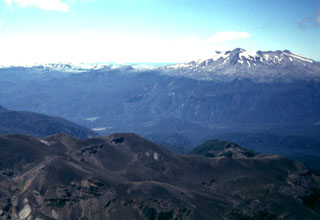Report on Puyehue-Cordon Caulle (Chile) — 27 April-3 May 2011
Smithsonian Institution / US Geological Survey
Weekly Volcanic Activity Report, 27 April-3 May 2011
Managing Editor: Sally Sennert.
Please cite this report as:
Global Volcanism Program, 2011. Report on Puyehue-Cordon Caulle (Chile) (Sennert, S, ed.). Weekly Volcanic Activity Report, 27 April-3 May 2011. Smithsonian Institution and US Geological Survey.
Puyehue-Cordon Caulle
Chile
40.59°S, 72.117°W; summit elev. 2236 m
All times are local (unless otherwise noted)
ODVAS-SERNAGEOMIN reported that on 26 April an overflight was conducted in response to recent increased seismicity and nearby residents noting fumarolic activity in the vicinity of Puyehue-Cordón Caulle. Scientists did not observe anything unusual that would indicate increased activity at Puyehue or Cordón Caulle, just typical fumarolic activity. On 27 April a seismic swarm was detected at depths of 4-6 km; a majority of the events were hybrid earthquakes and the largest was M 3.9. Seismicity decreased but was continuing through 29 April. The Alert Level was raised to 3, Yellow.
Geological Summary. The Puyehue-Cordón Caulle volcanic complex (PCCVC) is a large NW-SE-trending late-Pleistocene to Holocene basaltic-to-rhyolitic transverse volcanic chain SE of Lago Ranco. The 1799-m-high Pleistocene Cordillera Nevada caldera lies at the NW end, separated from Puyehue stratovolcano at the SE end by the Cordón Caulle fissure complex. The Pleistocene Mencheca volcano with Holocene flank cones lies NE of Puyehue. The basaltic-to-rhyolitic Puyehue volcano is the most geochemically diverse of the PCCVC. The flat-topped, 2236-m-high volcano was constructed above a 5-km-wide caldera and is capped by a 2.4-km-wide Holocene summit caldera. Lava flows and domes of mostly rhyolitic composition are found on the E flank. Historical eruptions originally attributed to Puyehue, including major eruptions in 1921-22 and 1960, are now known to be from the Cordón Caulle rift zone. The Cordón Caulle geothermal area, occupying a 6 x 13 km wide volcano-tectonic depression, is the largest active geothermal area of the southern Andes volcanic zone.
Source: Servicio Nacional de Geología y Minería (SERNAGEOMIN)

